Working around radiator in kitchen - new base cabinets
What kind of cabinets are you getting? We ended up building a cover for the radiator in the same shaker style as the cabinetsand putting a little shelf above to fill the gap between the counter and the radiator. The door opens downwards and holds our frequently used saucepans and skillets.
Eta our kitchen is not upside down.
We had the same issue- our radiator was in a set of cabinets, which really limited our use of space. We removed it and replaced it with a toe-kick radiator. I looove it and it's made a world of difference in our space efficiency! We were able to add a dishwasher which we didn't have before.
TarheelsInNj said:
We had the same issue- our radiator was in a set of cabinets, which really limited our use of space. We removed it and replaced it with a toe-kick radiator.
Same here. Very nice on cold mornings.
Could you replace with a newer slimmer version and mount it above the cabinetry?
When we remodeled our kitchen we bought a new radiator that sits only a few inches from the wall instead of the old cast iron units that need 8 inches. Examples of what I am referring to: http://steamradiators.com/cust-gallery.html
If you're opening the wall to the dining room (or other) and that space has a radiator, you may not need to keep the existing one, especially if you insulate. My former dining room (which became our kitchen) had a huge, ornate radiator under a triple window. This was to become my only wall of cabinets. Because we insulated and added archways, we moved that rad to the now adjacent family room. The thermostat is in the kitchen, and the kitchen never feels cold.
An electric kickspace heater or if you can arrange for air circulation a recessed cast iron radiator, Check out the Governale site.
Thanks all! Appreciate the ideas. I like the idea of covering the rad, like afa did, but a toe kick heater would allow more storage- plungy, do those work with steam heat?
I ought to be packing, rather than imaging my new kitchen- but I can't help myself!
Shh - I'll be in touch! Before kitchen happens, living & dining room first - and can't wait to see your ideas for the new space!
Boxes. Boxes
We actually removed the electric toe-kick heaters in our kitchen in the renovation. We added insulation to the walls and part of the ceiling that was directly under a roof, and found we could also remove one of the two steam units, and still had enough heat. If we had not been able to do that, we had designed a cabinet that had pierced metal inserts in the doors to use as a radiator cover, similar to what afa shows above, but more 'stealth.'
There is such a thing as steam baseboard heating, but I know nothing about it.
No kickspace for steam Pete. I've seen hot water models used in conjunction with a scavenger loop but I probably wouldn't recommend doing it that way. It would be much more expensive than an electric unit also because of all the near boiler work it would require and the piping.
I'm with Max though. I converted to hot water throughout my home with the intention of adding kicks when we did the kitchen. Haven't gotten around to it so far and the kitchen is not that bad in the winter.
You might try it. You can always add one if you need it later.
Plungy--what's the difference between steam and hot water--I thought they were the same...
Hot water -- there's a boiler - with one pipe that goes out (often to multiple zones), with hot water - not steam. It circulates through through the zones - typically radiators or baseboards. The cooler water returns to the boiler to be heated again through a second pipe on the radiator or baseboard. Its designed to be a closed system, eg, no water needs to be regularly added.
Steam -- there's a boiler, with one fairly large pipe that sends very very hot water -- well steam actually(!) into the radiators (not water). There is no circulating pump. Steam radiators have 1 pipe. The steam rises and heats the radiators to a quite high temperature. Once the steam cools, it condenses into water, and through the same pipe that delivered the steam to the radiator - returns to the boiler. Some steam is lost through the vents, and generally steam boilers need to be re filled.
of the 2 -- hot water is far more efficient, I believe its much more readily zoned, and IMO, a much more even heat.
We have an older kitchen, radiator against the wall by the sink. The previous owners put in the cabinets so that regular cabinets flanked the radiator on either side, and the radiator is in an enclosure, with that door having a wire lattice instead of a solid door. All the doors form a continuous line across, and the counter over the cabinets is continuous over the radiator. The set-up works, if you don't want to go with re-plumbing your heating system.
nohero said:
We have an older kitchen, radiator against the wall by the sink. The previous owners put in the cabinets so that regular cabinets flanked the radiator on either side, and the radiator is in an enclosure, with that door having a wire lattice instead of a solid door. All the doors form a continuous line across, and the counter over the cabinets is continuous over the radiator. The set-up works, if you don't want to go with re-plumbing your heating system.
That's exactly the setup we had! We pulled out that radiator and did the toe-kick instead, which wasn't an enormous plumbing job, but it made a huge difference in terms of space since we regained full use of those cabinets.


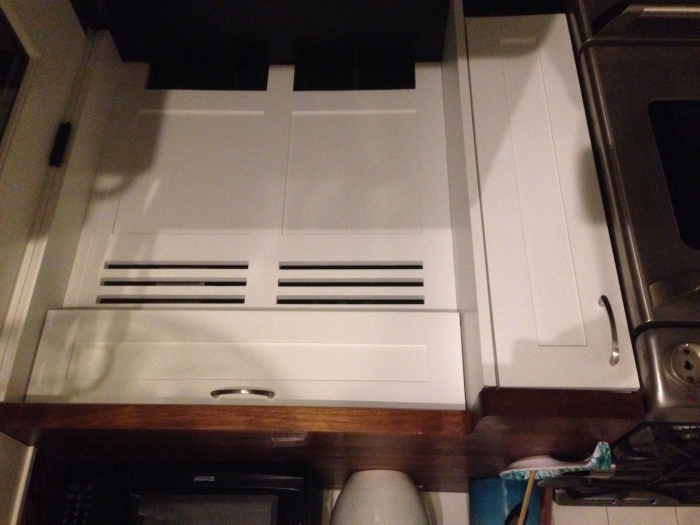









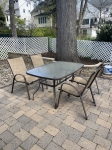

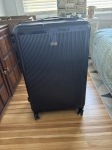
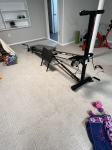

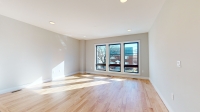

Want to run a row of base kitchen cabinets along a wall - where in the center is a steam rad.
No other wall space in the kitchen - it's all cabinets and appliances. The only other wall is coming down. Intending to keep existing terra cotta floor, so in floor heat not an option.
Would appreciate ideas! Run cabinets to either side and leave a gap? Leave it open? Put up a wooden or metal grille? Other magic!?!
Thanks for ideas!